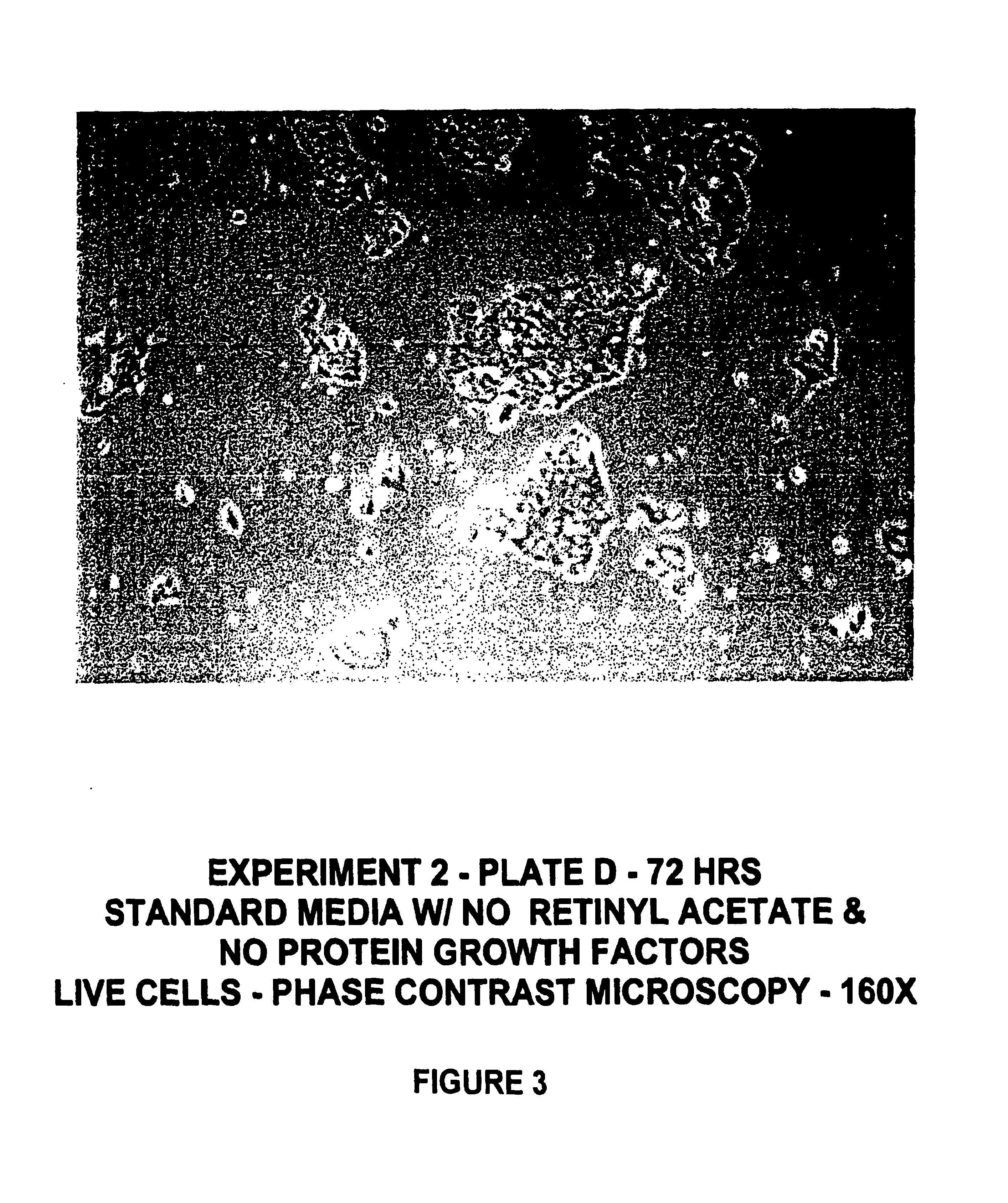Protein-free defined media for the growth of normal human keratinocytes
a keratinocyte and protein-free technology, applied in the field of biochemistry, can solve the problems of terminal differentiation, inability to control, and inability to grow achieve the effects of reducing the cell division capacity of normal human epithelial stem cells, and reducing the cell division capacity
- Summary
- Abstract
- Description
- Claims
- Application Information
AI Technical Summary
Benefits of technology
Problems solved by technology
Method used
Image
Examples
example 1
Primary and Secondary Culture of Normal Human Epidermal Keratinocytes in HECK-110 Protein-Free Defined Medium
Isolation of Basal Cells and Primary Cultures
[0119]Primary cultures of normal human basal epidermal keratinocytes were started by subjecting full-thickness skin samples to enzymatic digestion. Skin obtained from biopsies or autopsies was first cleaned of adhering subdermal fat and the dermis was reduced to less than 3 mm in thickness. The skin sample was then cut into 8 to 12 small pieces (usually 0.5 cm2). These pieces were floated on top of sterile CCS (Cell Competency Solution). CCS consisted of glucose, 10 mM; KCl, 3 mM; NaCl, 130 mM; Na2HPO4.7H2O, 1 mM; phenol red, 3.3 μM; HEPES at 23 mM; (See Shipley, G. D. and Ham, R. G., In Vitro 17:656-670 (1981)) and 0.17% trypsin (w / v) and 100 units / ml of both penicillin and streptomycin. After 14 to 16 hours of digestion at 4° C., the dermis was separated from the epidermis by a split-dermis technique. This was accomplished by pla...
example 2
Preparation of HECK-110 Basal Nutrient Medium
[0124]One aspect of the present invention relates to the preparation of a new media suitable for the large scale amplification of both primary and secondary cultures of normal human epithelial cells, such as keratinocytes, and for conversion of proliferating normal human epithelial monolayer cultures to a fully differentiated tissue transplantable to a human being. More particularly, this Example 2 is directed to the materials and procedures for preparation of a basal nutrient medium (Human Epidermal Cell Keratinocyte, HECK-110), and experiments evidencing its superiority in stimulating epithelial cell growth. The media according to this invention are novel and unobvious by design of the osmolarity, toxicity and pH-buffering properties.
[0125]Table 1 below details the concentration of components in basal medium, HECK-110. All biochemicals, growth factors and hormones were purchased from Sigma Chemical Company (St. Louis, Mo., U.S.A.), and ...
example 3
Growth of Secondary Cultures of Normal Human Epidermal Keratincytes in HECK-110 Protein-free Defined Medium
[0131]Human keratinocyte cultures were initiated from neonatal foreskin as described in Example 1, and then placed in secondary culture in complete HECK-109 FS medium. The purpose of the following experiment was to determine the effect of retinyl acetate on the proliferation of keratinocyte cultures refed HECK-109 basal medium lacking EGF and IGF-1 and supplemented with hydrocortisone, ethanolamine, and phosphoethanolamine. For this purpose, duplicate secondary cultures were refed either 1) complete HECK-109 FS medium (positive control) containing 0.1 mM Ca2+, 2) standard HECK-109 medium, i.e., basal medium supplemented with only hydrocortisone, ethanolamine, and phosphoethanolamine, and containing 0.1 mM Ca2+ and 3) standard HECK-109 supplemented with retinyl acetate (3×10−8M) (now called HECK-110). FIGS. 1-3 are phase contrast microscope photomicrographs of living cultures of...
PUM
| Property | Measurement | Unit |
|---|---|---|
| concentration | aaaaa | aaaaa |
| concentration | aaaaa | aaaaa |
| concentration | aaaaa | aaaaa |
Abstract
Description
Claims
Application Information
 Login to View More
Login to View More - R&D
- Intellectual Property
- Life Sciences
- Materials
- Tech Scout
- Unparalleled Data Quality
- Higher Quality Content
- 60% Fewer Hallucinations
Browse by: Latest US Patents, China's latest patents, Technical Efficacy Thesaurus, Application Domain, Technology Topic, Popular Technical Reports.
© 2025 PatSnap. All rights reserved.Legal|Privacy policy|Modern Slavery Act Transparency Statement|Sitemap|About US| Contact US: help@patsnap.com



